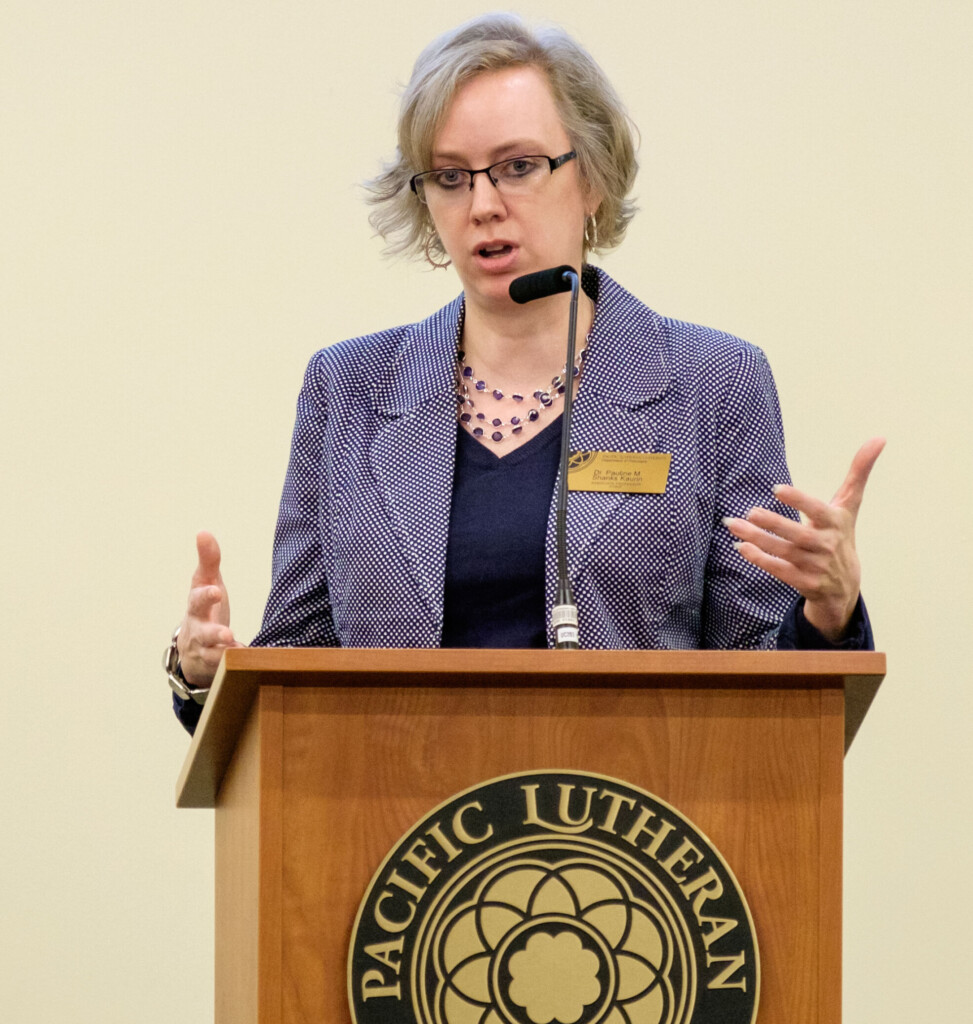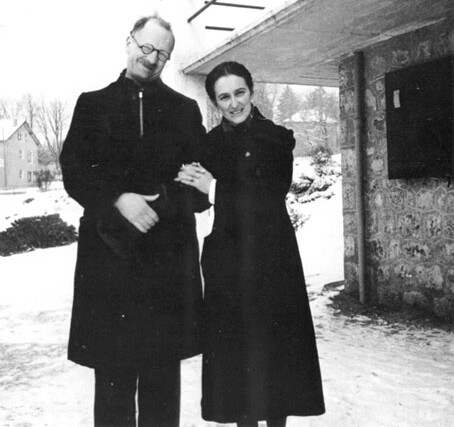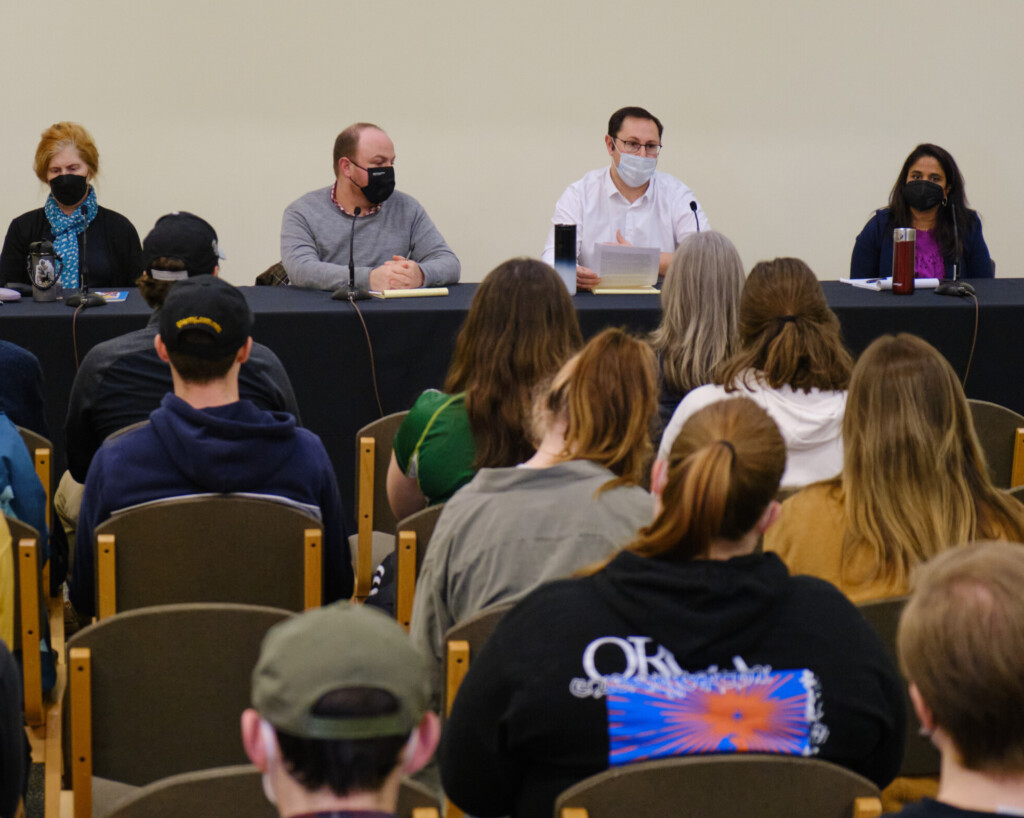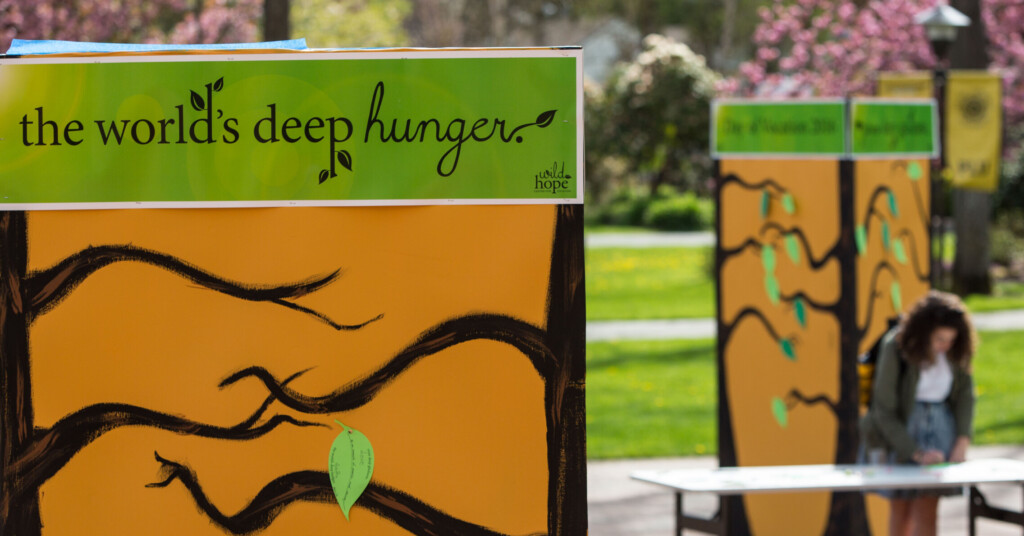Wanted: Fellow Conspirators
By Pauline M. Kaurin
Originally published in 2003
The daily headlines reflect the relentless march to war and violence: probable war in Iraq, continuing strife in the Middle East and the “war” on terror. Like other members of faith communities across the globe, I find myself wondering how I, how we, should respond to violence in our midst.1 These reflections have led me to wonder how other faith communities responded to violence and what lessons might be drawn for us, here at PLU.
The example that came to mind was Le Chambon-sur-Lignon, a small village in south central France, which during the days of World War II sheltered approximately 5,000 Jews and other refugees from the Nazis in what one of these sheltered children, film maker Pierre Sauvage, called “a conspiracy of Goodness.”2 During a time when many people found their consciences challenged to respond to the violence in their midst, one community led by two pacifist Huguenot pastors responded to violence with love, to hate with hospitality, to arrogance with humility and to human need with concrete action. Here I explore the lessons of Le Chambon and argue that, despite real differences between our times and communities, they have much to teach us in our own struggles against hate, violence and arrogance. I will likely raise more questions than can be answered here, but I pose these questions as a starting point for dialogue.
Le Chambon was above all defined as a community of believers. While faith communities usually share religious or spiritual traditions and beliefs, these common ties do not necessarily have to be religious in nature. Rather what binds faith communities are common attitudes, traditions, rituals, histories and understandings of the world. Here I want to avoid legitimate concerns that faith communities necessarily require all members to share the same perspective on all issues, to act/speak with one voice or act in the same way for the same reasons. The ties that bind faith communities can do so in different ways and with varying degrees of strength and consent.
What kind of faith community was Le Chambon? At first glance it might seem that Le Chambon was a homogenous community of Huguenot Christians who lived largely isolated from the outside world, but on closer inspection the situation is more complex. The village was mainly French Huguenot and much of the leadership came from the pastors, Andre Trocme and Eduard Theiss, both of whom shared this Huguenot Protestantism, as well as a strong pacifist, non-violent attitude rooted in Christianity.
However, there were a number of conservative Christians who according to the Bible did not recognize the authority of the clergy. In addition, there were Roman Catholics, those that were wary of religious dogma of any kind and, of course, the Jews being sheltered.

The diversity of this faith community can be seen poignantly in Pastor Trocme’s own family. Andre’s non-violence and Christianity were strongly intertwined and his life experiences had led him to understand that all human life, friend or foe, is precious.3 These attitudes were not necessarily supported by the Protestant clergy in France, or even in the village itself when the Trocmes arrived in 1934; Trocme and Theiss were a minority of two who objected to fighting the Germans and later to collaborating with them. While Andre’s wife shared some of his views, she had different reasons. She had a healthy skepticism of theology, and responded to people as concrete bodies in need of care. The people who came to her door needed food, shelter, and care, and Magda provided it or saw that it was provided by others.4 Like Magda, the pastor’s cousin, Daniel, who came to run one of the many schools in Le Chambon, had a strong aversion to religious dogma and was deeply suspicious of all narrow religious belief. However, he saw in the work at Le Chambon a chance to contribute to the betterment of humanity. All of these people shared common attitudes, commitments and acted upon them, but it was not necessary that the same ideas, understood in the same way, led them to these actions and commitments.
Le Chambon was a faith community founded not so much based upon an explicitly shared theological doctrine, but on a shared sense of identity, on common perspectives that allowed them to work in concert without having to coordinate and agree on a plan of action in advance. Out of necessity Pastor Trocme knew about many of the actions since he was both the spiritual head of the village and the one who acted as informal coordinator, but it would be easy to over state the influence of the leaders in the village. This was a struggle carried out in the kitchens of the farmhouses in and around Le Chambon, involving most of the village (men, women and children alike) but individuals made decisions and acted largely on their own and according to their own consciences.5

Why did it succeed? They had a sense of identity which was derived largely from their collective memory of events that had shaped their community. The Huguenot history of oppression and resistance as a religious minority was kept alive though hymns and other folklore which appeared on a regular basis in sermons, the church newspaper and through folk songs and stories which came to have meaning both as a remembrance of the past and instruction for the present.6 Even those that were not Huguenot, who did not explicitly share in this history, identified with elements of this history —whether it be the experience of minority status, experiences of persecution or a biblical heritage—and affirmed their part in the identity of Le Chambon. The villagers, Huguenot and otherwise, saw their current situation in terms of what had happened before: they called on this common memory and its resources to respond to their situation. This largely unspoken “conspiracy of Goodness” happened because they each acted as they saw fit, according to their own consciences, but in the context of a shared faith community and common history.
What are the insights that can be gleaned from Le Chambon? First, they responded where they were, in their own backyard, responding to the needs they saw when they saw them. It started gradually with small actions and small resistances which did not seem to have much significance at the time. Small actions rightly timed took on greater significance later and small actions prepared them, got them in the habit of effectively acting and resisting and most importantly, seeing that their actions and resistance could have an effect. “For them it was like having a new beautifully colored bird pointed out, a bird they had not seen before. But now that they saw it, they knew from their own experience that there was such a bird, and it could come back.”7
Second, they responded intentionally, with knowledge of what they were doing and cognizant of the possible dangers involved in their actions; they chose the path of disobedience to one authority, not only because it demanded the sacrifice of their own consciences, but also the sacrifice of the dignity and humanity of others. They understood that they might have to sacrifice their own moral purity to act, but they accepted this with open eyes and the oft repeated phrase, “What else could we do?”
Third, they responded authentically out of their history, identity and consciences. All of their history, beliefs, communal support, traditions and rituals prepared them for this work. They were used to having visitors, to being hospitable and as more refugees came, the pastors and the community committed themselves to the idea that refusing help was the same as doing harm; they decided to become a “city of refuge.” The village had become used to resisting authority that violated their consciences and individuals were used to acting on their own, but in a common cause. When the time came, they were well prepared and what seems to others to be an extraordinary task was “the normal thing to do.”8
Most importantly, they acted in a way that upheld the dignity of those they protected, as well as those they strove against. Andre Trocme preached that they were to resist with the “weapons of the spirit, but we will do so without fear, but also without hate and without hate.”9

Magda Trocme fed dinner to the Vichy police who came to arrest her husband, with the characteristically Chambonais attitude “What else could I do? They were hungry.” They saw the “enemy” as human beings, even as they recognized the reality of evil. They saw the Jews they sheltered also as beings with dignity; they even went so far as to preserve their relation with God, insisting that this tragedy would not be used to target the vulnerable and try to convert them. Further, these Christians went so far as to see that their guests were able to worship, to observe Sabbath and High Holy Days, and that the Orthodox Jews were able to keep kosher.10
While we might commend the actions of these people, Le Chambon was an isolated village in rural France during WWII when the evil was quite clear, not a part of multicultural community in a global village. How can these lessons apply to our faith community, which includes a kind of diversity that Le Chambon did not experience, and must engage a world far different from that of rural France in 1941-45? While on the surface our situations might look different, the essentials are the same. For its time and place Le Chambon was quite diverse, and shared many characteristics with PLU as a faith community. There were a fair number of Protestants, but also Catholics, Jews, conservative Christians and some who had doubts and skepticism about religion in general. They were a community with leaders, who had a religious and cultural tradition, but who also faced a changing world with pressing concerns and needs.
What are these lessons? What does Le Chambon teach us?
First, we can respond where we are, addressing the needs and concerns in our own backyard, including (but not restricted to) PLU and Parkland. When Andre Trocme went to the Quaker relief organization looking to help refugees from the war, he was told to go back to Le Chambon and make it a center, a safe place for children refugees – especially the Jews.11 And because he and others had laid the groundwork, Le Chambon was more than equal to the task – right in their own small corner of the world. While it is important to be global citizens concerned and engaged with the larger world, the training grounds for our ethical action starts in Parkland. How do we respond to the very real needs in our midst? What will we do when someone comes to our door, to my door, in need?

Second, we can respond authentically from our own identity that includes our history, traditions, rituals and common memory. How can we understand what is happening now in terms of what has gone before? What is that common memory, that which connects our past with our present and future? For PLU it might mean understanding the ties that bind: academic freedom, respect for the basic humanity of all persons, care for the earth, being a part of a community and called to vocations in the world.12 While many of these ideas can be seen as arising from the religious and historical tradition of Lutheranism, this does not and cannot mean that we all have to understand these ideas in the same way.
Like the non-Huguenot villages of Le Chambon, some of us at PLU may connect and identify with these ties that bind drawing on our own experiences, histories, traditions and spiritual views. Nevertheless we, as a faith community, do share these commitments even if we act on them differently. Maintaining these ties that bind will also mean being attentive to our common memory and history. This is not restricted to the official institutional histories and memories (although they are clearly important), but should also include the histories and stories of all the members of the community: students, alumni, staff, administration and faculty alike. What story will they tell about PLU and its place in the world? How can the stories of the past help us respond to the present and future?
Third, and most importantly, we must respond in a way that respects the humanity of those we seek to help as well as those we seek to oppose. This is not contingent on how we perceive that others treat us, but on their and our common humanity. When we look at what kind of conspirators the people of Le Chambon were, we see they were committed without being narrow-minded, coordinated without an institutional hierarchy, insistent without being arrogant and resistant to evil without demonizing those they saw as responsible for that evil. What kind of conspirators will we be? What might a “conspiracy of Goodness” look like at PLU?
Notes
1 – An earlier version of this paper was presented to one of the Peace Studies Seminars in Fall 2002 and I heartily thank all the participants for their insights and ideas: Beth Kraig, Ione Crandall, Alexa Folsom-Hill, Chelsee Slemp, Ryan Neary, Kat Kempe and Vesna Hoy.
2 – Weapons of the Spirit, Pierre Sauvage, First Run Features, 1990. Videocassette.
3 – Phillip Hallie, Lest Innocent Blood Be Shed (New York: Harper and Rowe, 1979), p 45ff.
4 – Ibid, p 65
5 – Ibid, p 10ff
6 – Ibid, p 26ff. Roger Darcissac functioned as a historian of sorts for the village, publishing folks songs with Morse Code drawings which carried on the theme of resistance familiar to the Chambonais from their Huguenot history.
7 – Ibid, p 91.
8 – “City of Refuge” derives from an Old Testament idea that one who comes to the gates is to be protected or the guilt of any bloodshed is imputed on the inhabitants of that city. See Deuteronomy 19:10.
9 – Weapons of the Spirit
10 – Lest Innocent Blood Be Shed, p 55
11 – Ibid, p 136ff
12 – Adapted from Dr. Samuel Torvend, “Five Free Gifts for your Journey at PLU,” Address given at First Year Orientation, Pacific Lutheran University, September 6, 2002.


